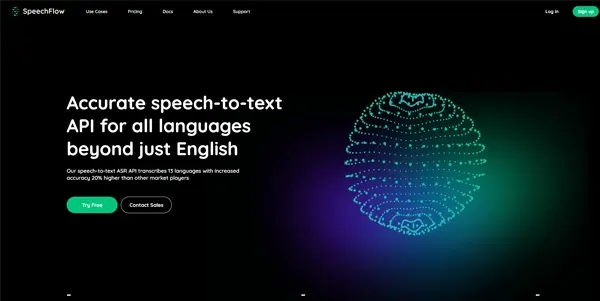SpeechFlow

Use an API to build your text-to-speech applications. Accessible in several languages
SpeechFlow: A Comprehensive Guide to the Text-to-Speech API
SpeechFlow is a powerful and versatile text-to-speech (TTS) API designed for developers seeking to seamlessly integrate high-quality speech synthesis into their applications. It offers access to a wide range of voices and languages, providing a streamlined solution for building robust and engaging voice-enabled experiences. This article delves into the capabilities, applications, and comparative advantages of SpeechFlow.
What SpeechFlow Does
SpeechFlow leverages a sophisticated API to convert written text into natural-sounding speech. Developers can integrate this API into their applications, websites, or platforms to add text-to-speech functionality without needing extensive in-house expertise in speech synthesis. The API handles the complex process of converting text into audio, allowing developers to focus on the overall functionality and user experience of their product.
Main Features and Benefits
- Multilingual Support: SpeechFlow boasts support for numerous languages, enabling developers to create applications with global reach. The exact number of supported languages may vary, and it's essential to check the official SpeechFlow documentation for the most up-to-date list.
- High-Quality Audio: The API utilizes advanced speech synthesis techniques to generate clear, natural-sounding speech, minimizing robotic or artificial qualities. This ensures a more engaging and user-friendly experience.
- Customizable Voices: While specific options depend on the SpeechFlow plan, the potential for voice customization (e.g., tone, pitch, speed) allows developers to fine-tune the audio output to perfectly match their application's style and branding.
- Easy Integration: The API is designed for ease of use and integration into various development environments and programming languages. Comprehensive documentation and SDKs typically simplify the implementation process.
- Scalability: SpeechFlow's API is designed to handle varying levels of usage, making it suitable for applications ranging from small-scale projects to large-enterprise deployments.
Use Cases and Applications
The applications of SpeechFlow are vast and span multiple industries:
- Accessibility: Creating accessible applications for users with visual impairments, providing audio versions of text-based content.
- Education: Developing interactive learning tools with voice narration and feedback.
- Gaming: Enhancing gaming experiences by adding voiceovers, character dialogue, or in-game announcements.
- Customer Service: Building interactive voice response (IVR) systems and chatbots with natural-sounding speech.
- Automotive: Integrating voice-controlled navigation, alerts, and entertainment systems.
- E-learning platforms: Providing audio versions of course materials.
- Audiobook creation: Generating audio versions of books and other text-based content.
Comparison to Similar Tools
SpeechFlow competes with other prominent TTS APIs in the market, such as Amazon Polly, Google Cloud Text-to-Speech, and Microsoft Azure Text-to-Speech. A direct comparison requires analyzing specific features, pricing models, and performance benchmarks for each API. Key differentiators to consider include the quality of the generated speech, the range of supported languages and voices, the ease of integration, and the overall cost-effectiveness. SpeechFlow's competitive advantage may lie in a specific area like a particular language support, pricing structure, or advanced voice customization features. Thorough evaluation of each competitor's documentation is crucial for informed decision-making.
Pricing Information
SpeechFlow operates on a paid model. Specific pricing details—including per-character pricing, monthly fees, or tiered plans—are usually available on the official SpeechFlow website. It's important to review the pricing structure to determine the best plan based on your projected usage and budget. Free trial periods are often offered to allow developers to test the API and evaluate its suitability before committing to a paid subscription.
Disclaimer: This article provides general information about SpeechFlow based on common features of text-to-speech APIs. Specific details, such as pricing, supported languages, and features, should be verified on the official SpeechFlow website.